Like a typical two-year-old, Jacob Burmeister loves dinosaurs, toy trucks, Peppa Pig and shoulder rides from Dad. But Melbourne’s “butterfly boy” is anything but typical.
Every morning, it takes three carers two hours to wrap Jacob in layers of thick foam and bandages from head to toe before he can safely face the world.
Jacob has a rare disease called recessive dystrophic epidermolysis bullosa, a genetic condition that causes extremely fragile skin.
The slightest friction can cause painful wounds similar to third degree burns.
Even a loving bear hug from his big sister or a tumble on the grass can tear Jacob’s fragile skin.
It’s not easy for parents Nathan and Lauren Burmeister when the adventurous tot just wants to explore the world.
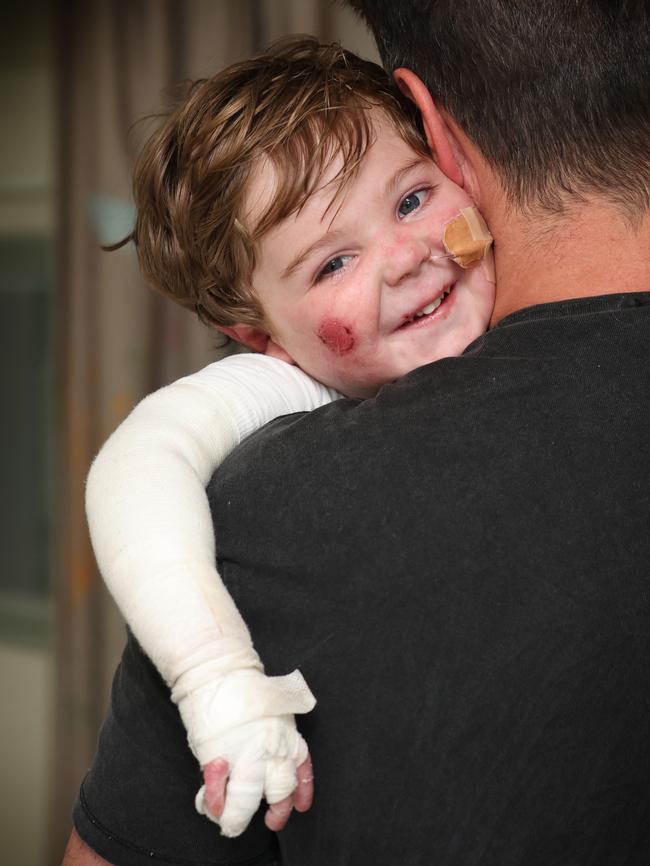
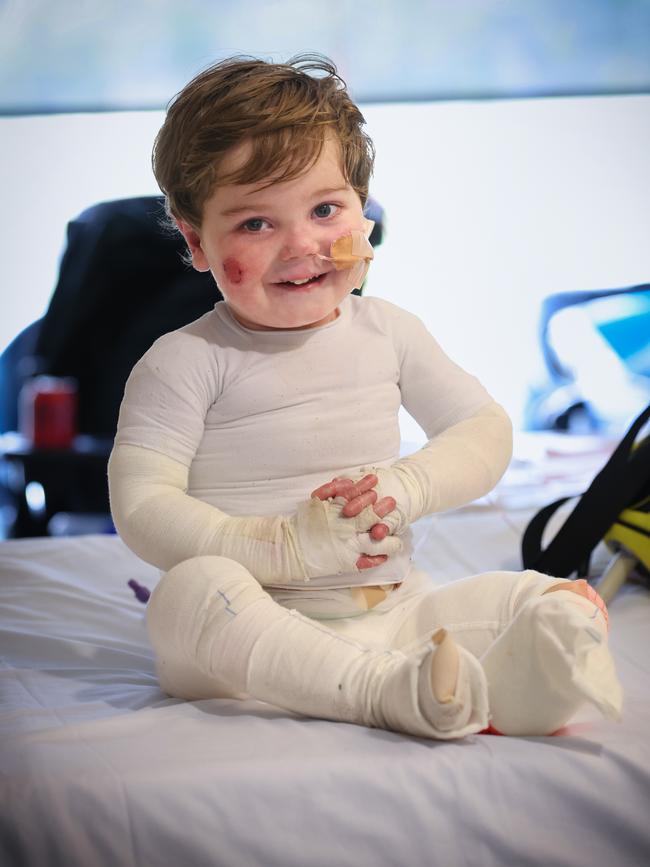
“He doesn’t know he has EB – so he just wants to do all the fun things,” Mr Burmeister said.
Jacob’s mum calls the cheeky tot an “adrenaline junkie”.
“We went to the snow last year and his favourite thing was going fast down the hill on the doughnuts,” Mrs Burmeister said.
For Mr Burmeister, “butterfly children” is a fitting name for vulnerable kids like Jacob.
“If you have a butterfly, you grab this beautiful thing and you’ve got to be gentle with it,” he said.
“It’s the same with Jacob – you just want to squeeze him and hug him but you’ve got to be gentle.”
It takes a team of 12 NDIS and RCH nurses and carers on a rotating 24/7 roster in the Burmeisters’ home to keep Jacob’s life running smoothly.
His day begins at 7am when a nurse arrives at the family’s home in Yarraville in Melbourne’s inner west and administers a raft of medications.
Jacob’s skin is so fragile that his nurses can’t even wear gloves because the friction would tear his skin and cause blisters.
As part of Jacob’s four-hour morning routine, his old dressings are removed, he has a bleach and salt bath to disinfect wounds all over his body, and his blisters are popped to prevent them spreading.
Then he is carefully covered in two layers of 5mm-thick foam pads, a layer of gauze bandages and a final layer of compression stockings.
“I’m a structural engineer and I think of it as an exoskeleton, a whole new layer of skin to protect him,” Mr Burmeister said.
“It helps a little bit, but it’s not foolproof and lots of injuries still occur.”
Afternoons are spent out and about, whether at daycare, where he started in January, at playgrounds, visiting cafes, or appointments at the RCH.
When Jacob was born, he was missing the skin on almost his entire left leg.
“Huge joy turned into huge fear pretty quick,” Mr Burmeister said.
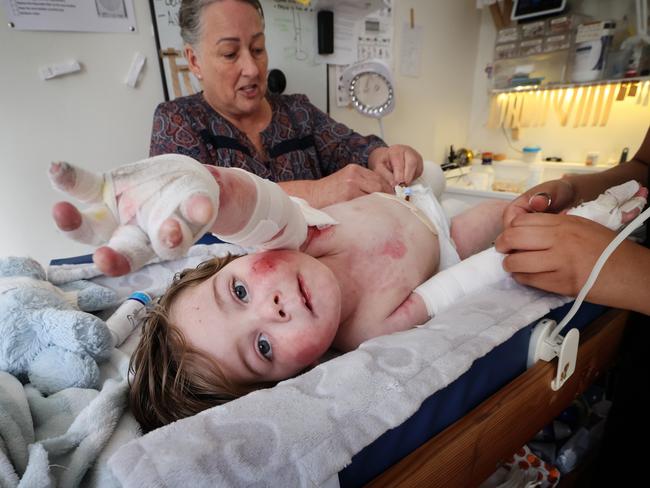
After the diagnosis a week later, the fear only deepened.
There are various types of EB, but “Jacob happens to have the nasty one”.
“If you’ve ever Googled recessive dystrophic EB, it was scary to look at the prognosis for him,” Mr Burmeister said.
“So just to paint a picture, these kids historically live up to between 18 and 30 years old.
“It’s living a life with bandaging every single day, and pain and poor sleep and immobility, and so it was scary, very, very confronting.”
Jacob can’t eat and is liquid fed via a tube directly into his gut.
Lauren Weston, Jacob’s EB clinical nurse consultant at the RCH, has known Jacob since he was days old, and says his progress since then has been “amazing”.
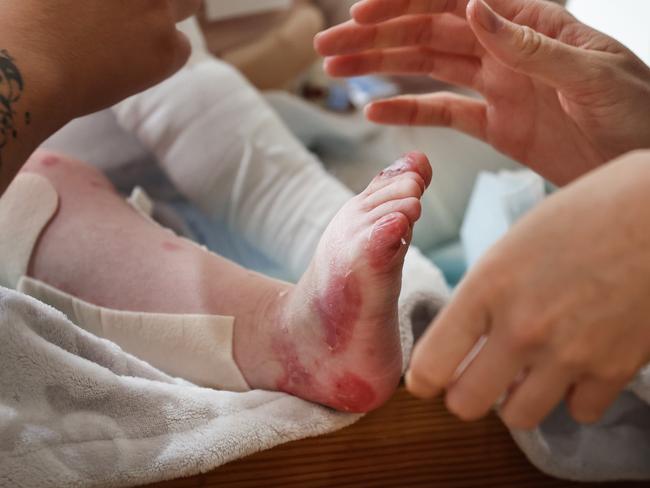
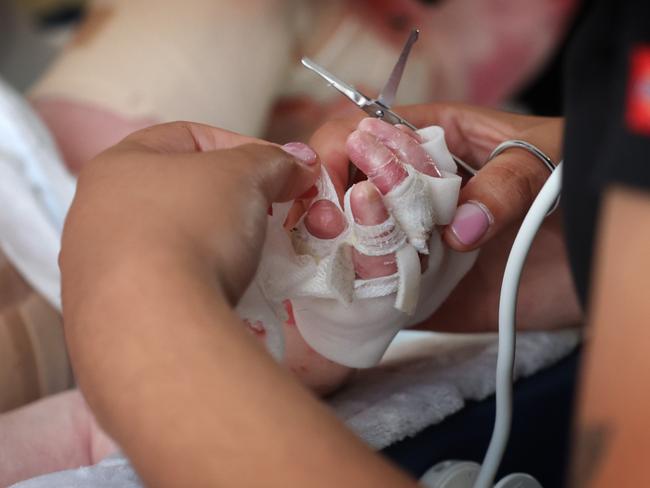
“We knew his EB was going to be pretty bad, but to see what he can do is extremely uplifting,” she said.
“He does go through pain every single day, yet his family give him every opportunity to do things, and his zest for life is quite remarkable.
“For him to be able to go to childcare with all that’s going on with him is amazing.”
Incredibly, the skin on Jacob’s left leg has never grown since he was born.
Every morning, nurses clean and dress the open wound on his leg, as well as all the new wounds and blisters all over his body.
Jacob’s sister Hannah had to learn how to cuddle him extra gently.
“I mean she’s a typical five-year-old just wanting to play and hug him, and so there are times when she’ll hug him so tight I’m like, ‘oh’,” Mr Burmeister said.
“But then you also want them to play naturally, so we’re a bit careful about saying ‘stop’. It’s a balance. He will get injured. It’s inevitable. You’ve got to mind yourself from being too much of a helicopter parent.”
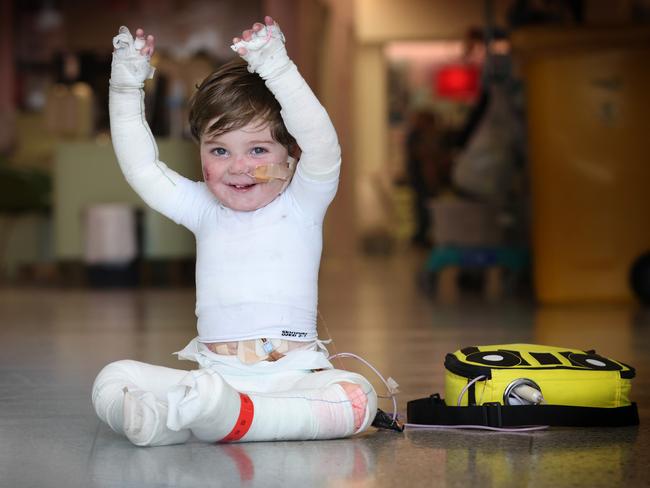
The Burmeisters are hopeful Jacob will soon gain access to a life-changing drug called Vyjuvek, which is already readily available in the US to kids with EB.
But it comes with a whopping price tag: $1.5m a year.
“In simple terms, by just dropping a cream on his leg, it would heal a leg that hasn’t healed in two years, it would probably allow him to walk, it will reduce his risk of cancer, probably elongate his life to our lifespans, it’s hugely promising,” Mr Burmeister said.
“And in the US, insurers take care of the cost.”
Jacob has been to the RCH more than 100 times in his first two years.
“The staff have got to know him and us them and it’s become a personal relationship with many of the staff,” Mr Burmeister said.
“We’ve been to music festivals with them.
“Dr Tom Connell, who’s his pediatrician, is extremely caring. He will text me late at night with updates to Jacob’s blood results.
“You just feel like you’ve got someone genuinely in your corner.”
Jacob has one of the most severe cases of his disease seen at the RCH.
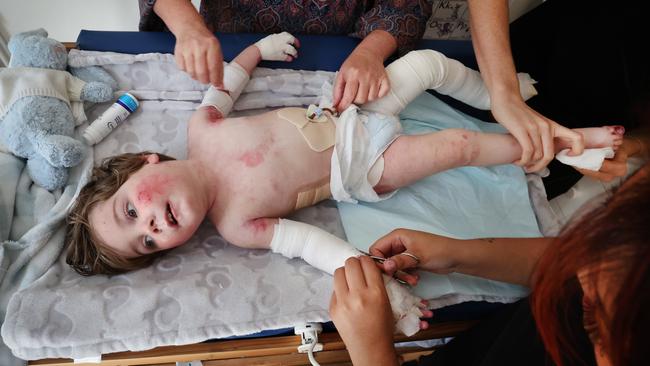
Dr Connell, who is also the RCH’s chief medical officer, said it took up to 30 health professionals to care for each patient like Jacob.
“It’s often said that it takes an army of people to raise a child with EB,” he said.
“Day-to-day life for someone who’s got recessive dystrophic epidermolysis bullosa is incredibly challenging.”
Jacob must wear elastic-free nappies because elastic will tear his fragile skin, and nappy changes take 45 minutes because of his head-to-toe bandages.
Kids with EB usually get progressively worse, Mr Burmeister said.
“Jacob’s EB means he can’t walk or crawl, he’s got internal problems unfortunately, he’s on a lot of pain medication,” he said.
“The traditional future of someone with EB is your fingers fuse, your toes fuse, cancer takes over, you get amputations, you can hardly move, you’re in a wheelchair, you can’t eat, it’s awful.”
But the Burmeisters are hopeful Jacob has a long and bright future ahead.
“Despite all that he’s a happy guy, there’s a lot of hope for this kid’s future and he’s doing really well,” Mr Burmeister said.
“There’s a lot of hope for EB, with about 40-plus clinical trials occurring at the moment.
“And there are people who believe we can cure EB in the next decade.”
To help children like Jacob, donate to the Good Friday Appeal.

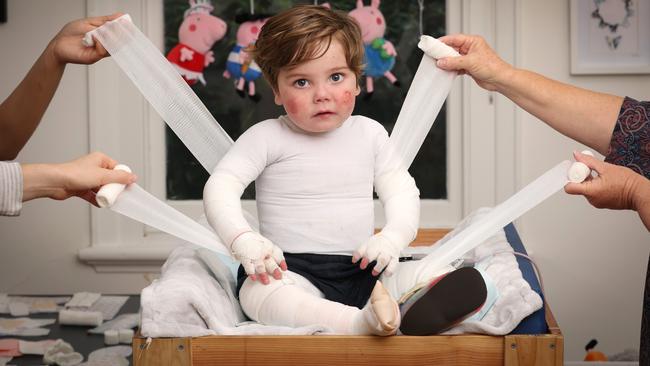
Add your comment to this story
To join the conversation, please log in. Don't have an account? Register
Join the conversation, you are commenting as Logout
Good Friday Appeal raises record $23m+ for Vic’s sick kids
The Good Friday Appeal has raised a record $23,822,792 for the state’s sickest kids as Victorians generously donated to help the Royal Children’s Hospital.
‘I’ll never give up’: Liana fights back after horror hand injury
Sports-mad teenager Liana is refusing to let a horror hand injury slow her down, and after undergoing 20 surgeries at the Royal Children’s Hospital she is now aiming to make the Australian Paralympic ski team.